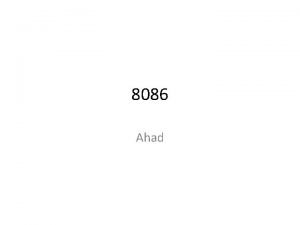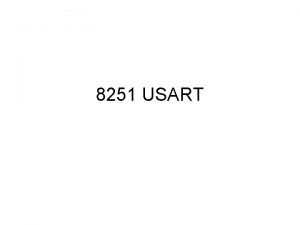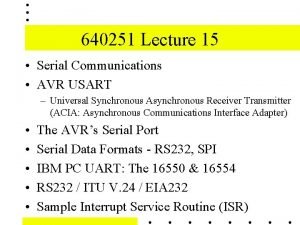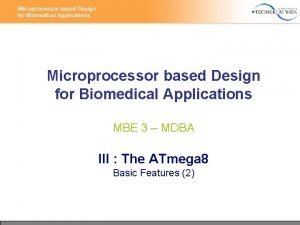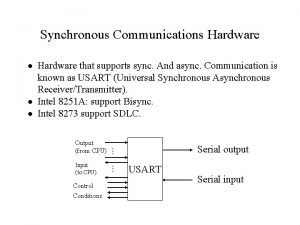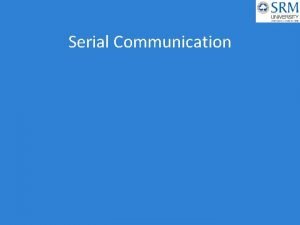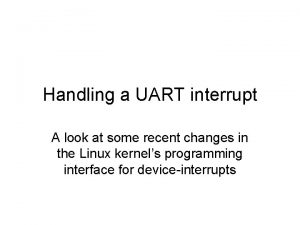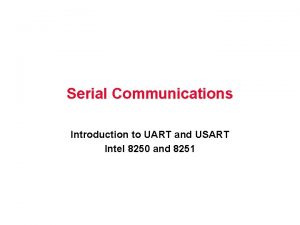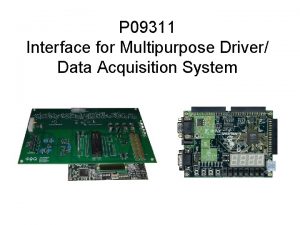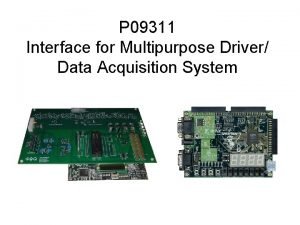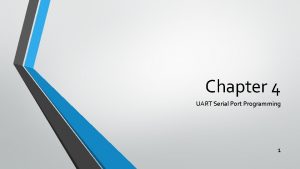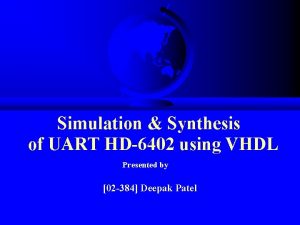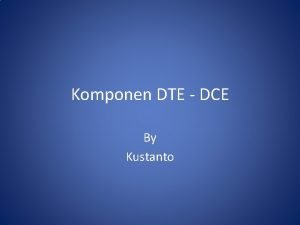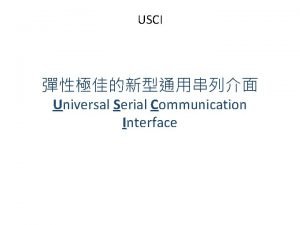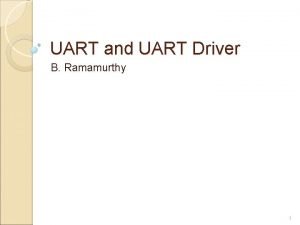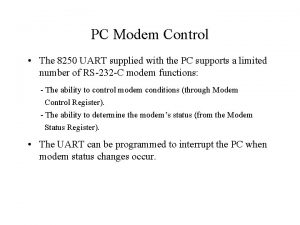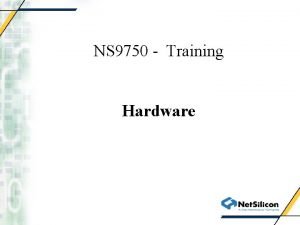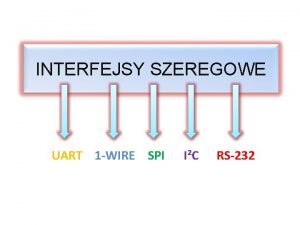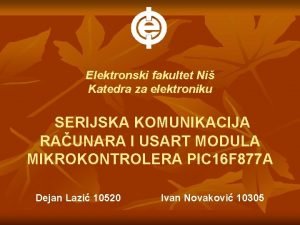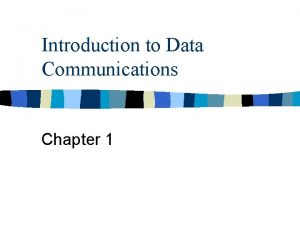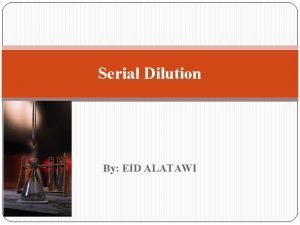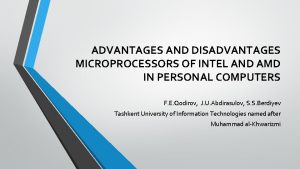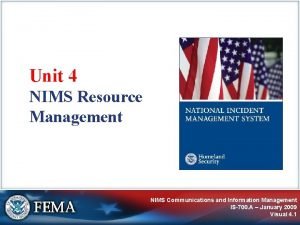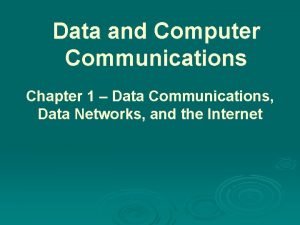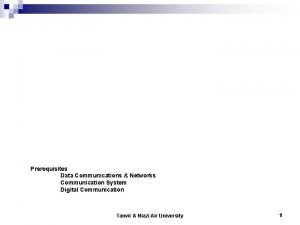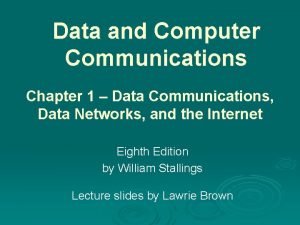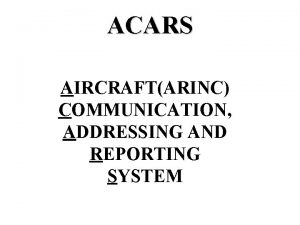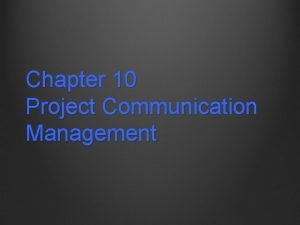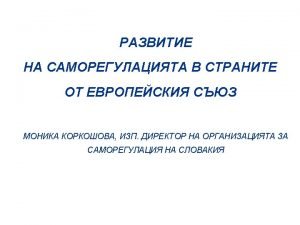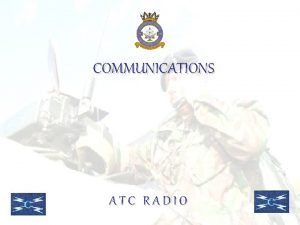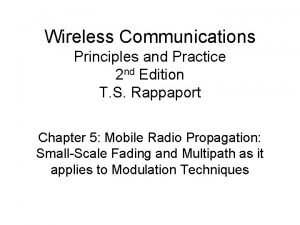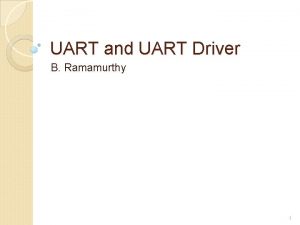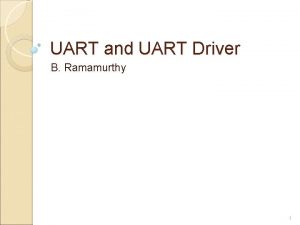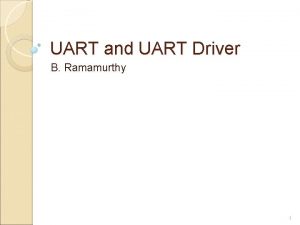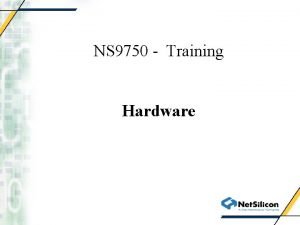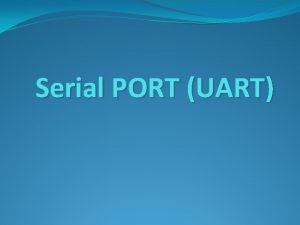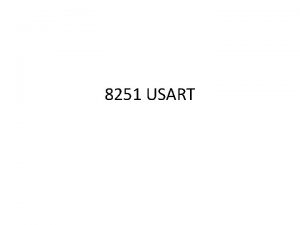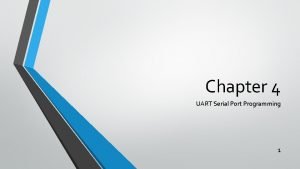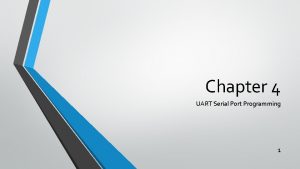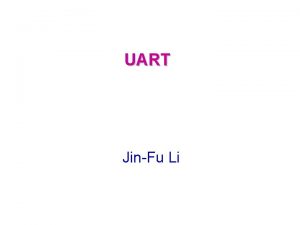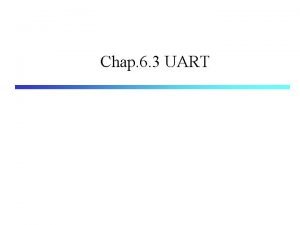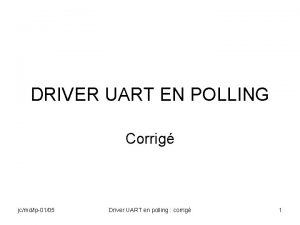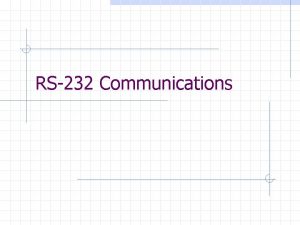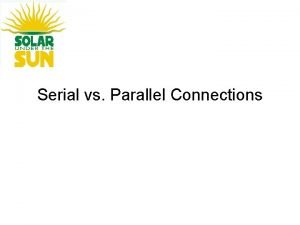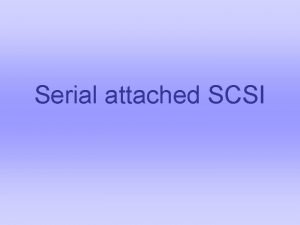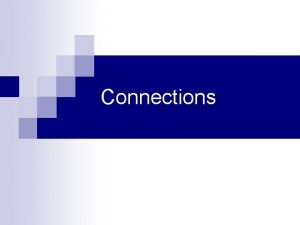Serial Communications Introduction to UART and USART Intel














































![8251 USART Interface 8251 D[7: 0] RD WR A 0 CLK A 7 A 8251 USART Interface 8251 D[7: 0] RD WR A 0 CLK A 7 A](https://slidetodoc.com/presentation_image_h2/424b64159985314c97a3f944f4c76dc3/image-47.jpg)




- Slides: 51

Serial Communications Introduction to UART and USART Intel 8250 and 8251

Outline • Concept of serial communications • Synchronous, Asynchronous • RS-232 standard • Hand shaking • UART and USART chips • 8250 and 8251 chips

What is Serial Communication

Serial Communication Types • In Terms of Data on a Line – Asynchronous – Synchronous • In Terms of Number of Senders – Simplex – Half duplex – Full duplex

Transfer Types

Asynchronous Data Framing Sending Character ‘A’ = 0 x 41 on the Line Idle (high): Mark Low: Space Overhead? (parity, start, stop)

Vocabulary • DTE – data terminal equipment – e. g. computer, terminal • DCE – data communication equipment – connects DTE to communication lines – e. g. modem • Data Transfer Rate – Baud Rate – BPS Baud (Symbol representing n bits) Bit per second

RS-232 Standard • EIA 232 = ITU-T V. 24/V. 28 • Specifies the interface between DTE and DCE: – V. 28 : mechanical and electrical characteristics – V. 24 : functional and procedural characteristics • Even used in applications where there is no DCE – e. g. connecting computer to printer, magnetic card reader, robot, … etc. • Introduced in 1962 but is still widely used • Stand for Recommended Standard

DTE Connections

Mechanical Characteristics • 25 -pin connector – 9 -pin connector is more commonly found in IBM-PC but it covers signals for asynchronous serial communication only • Use male connector on DTE and female connector on DCE • Note: all signal names are viewed from DTE

25 -Pin RS 232 Connector

9 -Pin RS 232 Connector

Electrical Characteristics • Single-ended – one wire per signal, voltage levels are with respect to system common (i. e. signal ground) • Mark: – 3 V to – 15 V – represent Logic 1, Idle State (OFF) • Space: +3 to +15 V – represent Logic 0, Active State (ON) • Usually swing between – 12 V to +12 V • Recommended maximum cable length is 15 m, at 20 kbps

TTL to RS-232 Line drivers and line receivers

RS-232 Frame Format Example … Start bit ASCII Parity 111101000001111 Idle A Stop bit

RS 232 Logic Waveform

Function of Signals • TD: transmitted data • RD: received data • DSR: data set ready – indicate whether DCE is powered on • DTR: data terminal ready – indicate whether DTR is powered on – turning off DTR causes modem to hang up the line • RI: ring indicator – ON when modem detects phone call

Function of Signals • DCD: data carrier detect – ON when two modems have negotiated successfully and the carrier signal is established on the phone line • RTS: request to send – ON when DTE wants to send data – Used to turn on and off modem’s carrier signal in multi-point (i. e. multi-drop) lines – Normally constantly ON in point-to-point lines • CTS: clear to send – ON when DCE is ready to receive data • SG: signal ground

Flow Control • Means to ask the transmitter to stop/resume sending in data • Required when: – DTE to DCE speed > DCE to DCE speed (e. g. terminal speed = 115. 2 kbps and line speed = 33. 6 kbps, in order to benefit from modem’s data compression protocol) » without flow control, the buffer within modem will overflow – sooner or later – the receiving end takes time to process the data and thus cannot be always ready to receive

Hardware Flow Control • RTS/CTS – the transmitting end activates RTS to inform the receiving end that it has data to send – if the receiving end is ready to receive, it activates CTS – normally used between computer and modem » computer is always ready to receive data but modem is not, because terminal speed > link speed

Software Flow Control • Xon/Xoff – when the buffer within the receiving end is nearly full, Xoff is sent to the transmitting end to ask it to stop – when data have been processed by the receiving end and the buffer has space again, Xon is sent to the transmitting end to notify it to resume – advantage: only three wires are required (TD, RD and GND) – disadvantage: confusion arises when the transmitted data (e. g. a graphics file) contains a byte equal to 13 H (Xoff)

RS-232 (con) • Communication between two nodes Software Handshaking Hardware Handshaking data transmission CTS TD data transmission No Yes Send character RTS CTS RD receiver transmitter x-on receiver transmitter x-off Are you ready to RTS receive?

Null Modem Cables • Used to directly connect two DTEs together • Many possibilities – depending on whether and how the two DTEs handshake (i. e. doing flow control)

Null Modem Cables Examples

Other Standards

UART in PC 115200*16=1843200

8250/16450/16550 UART

Registers • Transmitter holding register • Receiver buffer register • Interrupt enable register

Registers • Interrupt identification register

Line Control

Modem Registers Modem Control Register Modem Status Register

Line Status

Divisor Register

Example Program the divisor Latch for 300 baud. Assume Xin=1. 8432 MHz The Base Address: 0 x 3 F 8

Example 2 Program the divisor Latch for 2400 baud. Assume Xin=1. 8432 MHz The Base Address: 0 x 3 F 8

Example 3 Program 8250 for 2400 baud, 8 data bit, even parity and 1 stop bit. Assume Xin=1. 8432 MHz The Base Address: 0 x 3 F 8 MOV MOV OUT MOV INC OUT MOV OUT AL, 80 H DX, 3 FBH DX, AL AX, 48 DX, 3 F 8 H DX, AL AL, AH DX DX, AL AL, 00011011 DX, 3 FBH DX, AL ; Accessing DLAB ; Line Control Register Address ; baud=2400 115200: 48=2400 ; Low byte of Divisor ; DLAB, Break, Even, 1 stop, 8 data ; LCR

Synchronous Protocols

CRC In SDLC: G(X) = x**16 + x**12 + x**5 + 1

8251 Block Diagram

8251 Registers

Mode Register

Mode Instruction (Asynchronous)

Mode Instruction (Synchronous)

Command Register

Status Register

8251 Timing
![8251 USART Interface 8251 D7 0 RD WR A 0 CLK A 7 A 8251 USART Interface 8251 D[7: 0] RD WR A 0 CLK A 7 A](https://slidetodoc.com/presentation_image_h2/424b64159985314c97a3f944f4c76dc3/image-47.jpg)
8251 USART Interface 8251 D[7: 0] RD WR A 0 CLK A 7 A 6 A 5 A 4 A 3 A 2 A 1 IO/M Tx. D RD WR C/D CLK Rx. D Tx. C RS 232

Programming 8251 q 8251 mode register 7 6 5 Number of Stop bits 00: 01: 10: 11: invalid 1 bit 1. 5 bits 2 bits 4 3 Parity enable 0: disable 1: enable Parity 0: odd 1: even 2 1 0 Mode register Baud Rate 00: 01: 10: Character length 11: 00: 5 bits 01: 6 bits 10: 7 bits 11: 8 bits Syn. Mode x 1 clock x 16 clock x 64 clock

Programming 8251 q 8251 command register EH IR RTS ER SBRK Rx. E DTR Tx. E: transmit enable DTR: data terminal ready Rx. E: receiver enable SBPRK: send break character ER: error reset RTS: request to send IR: internal reset EH: enter hunt mode command register

Programming 8251 q 8251 status register DSR SYNDET FE Tx. RDY: Rx. RDY: Tx. EMPTY: PE: OE: FE: SYNDET: DSR: OE PE Tx. EMPTYRx. RDY Tx. RDY transmit ready receiver ready transmitter empty parity error overrun error framing error sync. character detected data set ready status register

Simple Serial I/O Procedures q Read q Write start Check Rx. RDY Check Tx. RDY Is it logic 1? No Is it logic 1? Yes Read data register* end * This clears Rx. RDY No Yes Write data register* end * This clears Tx. RDY
 Block diagram of 8086 microprocessor
Block diagram of 8086 microprocessor Txempty goes high when
Txempty goes high when Avr usart interrupt example
Avr usart interrupt example Mdba
Mdba 8251a usart
8251a usart 8251a usart
8251a usart Uart irq handler
Uart irq handler Hdlc uart
Hdlc uart 8251 uart
8251 uart Uart rx
Uart rx Uart rx
Uart rx Samd21 uart example
Samd21 uart example 6402 uart
6402 uart Sci serial communication interface
Sci serial communication interface Uart logo
Uart logo Uart dte
Uart dte Confirmtx
Confirmtx Uart driver
Uart driver 8250 uart
8250 uart Uart hdlc
Uart hdlc 3-wire serial interface
3-wire serial interface Programiranje mikrokontrolera
Programiranje mikrokontrolera Piso shift register circuit diagram
Piso shift register circuit diagram Dramaserial.tv semi
Dramaserial.tv semi Introduction to data communications and networking
Introduction to data communications and networking Introduction to data communications
Introduction to data communications Serial dilution
Serial dilution Disadvantages of amd processor
Disadvantages of amd processor Track and report nims
Track and report nims Means of telecommunication
Means of telecommunication Ministry of transport cyprus
Ministry of transport cyprus Global marketing communications
Global marketing communications Data and computer communications 10th edition
Data and computer communications 10th edition Data and computer communication
Data and computer communication Backbone network components
Backbone network components Business data communications and networking
Business data communications and networking Designing and managing marketing communications
Designing and managing marketing communications Digital communications and networks impact factor
Digital communications and networks impact factor K state communications and marketing
K state communications and marketing Data and computer communications
Data and computer communications Chapter 4 communications and documentation quiz
Chapter 4 communications and documentation quiz Business communications process and product
Business communications process and product Business communications process and product
Business communications process and product What is acars system
What is acars system Designing and managing integrated marketing communications
Designing and managing integrated marketing communications Monitor communications process tools and techniques
Monitor communications process tools and techniques Attitudes and persuasive communications
Attitudes and persuasive communications Simplified data communication model
Simplified data communication model Easa advertising
Easa advertising Atc communications and radio procedures
Atc communications and radio procedures Designing and managing integrated marketing channels
Designing and managing integrated marketing channels Geomerty
Geomerty
